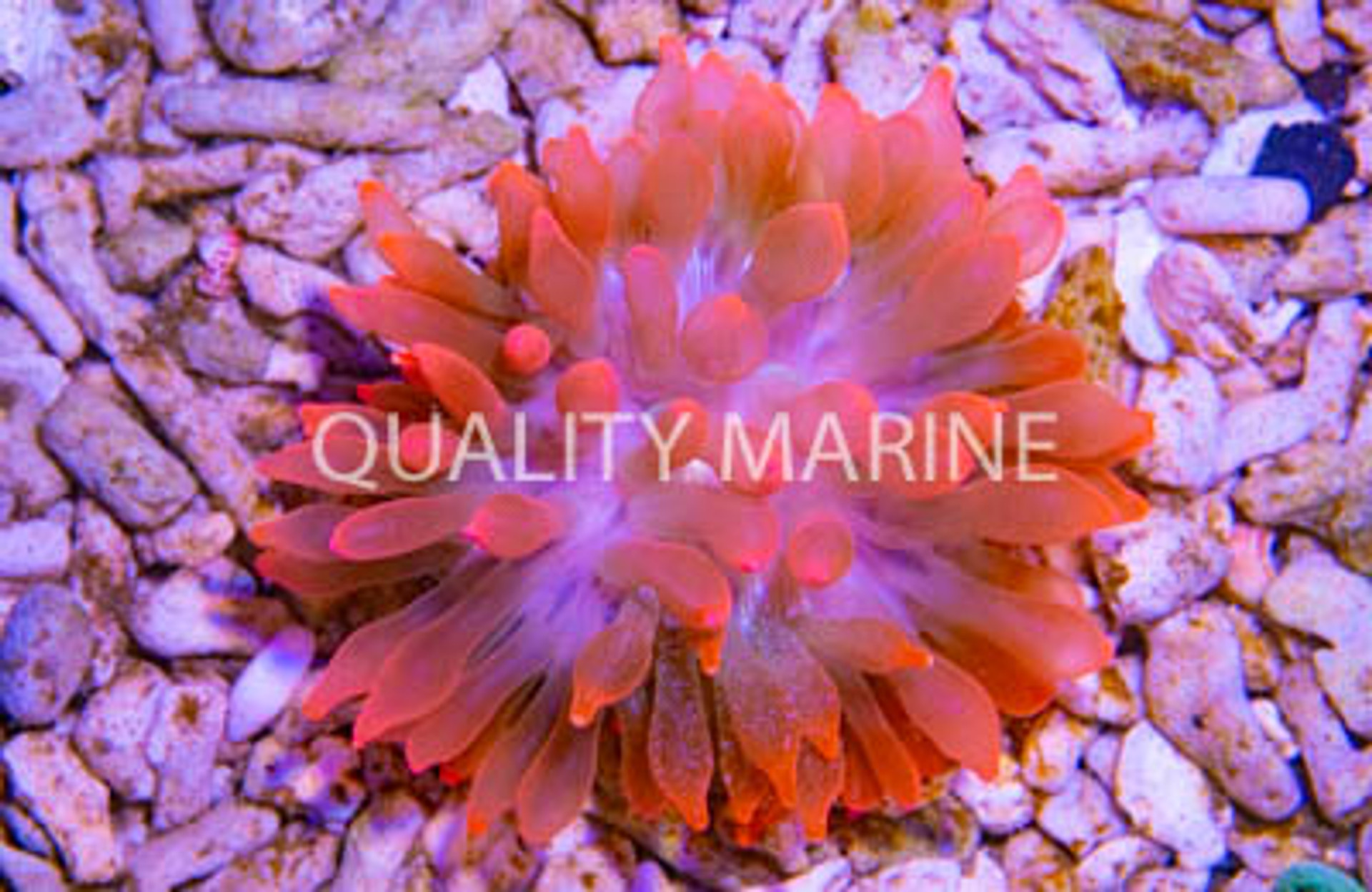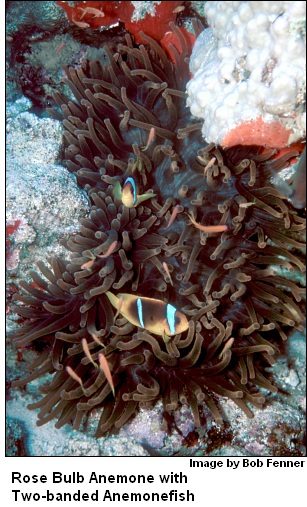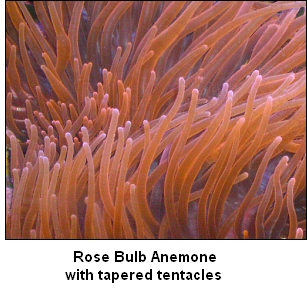Bulb Anemone

Scientific name: Entacmaea quadricolor
Common name: Bulb Anemone, Bubble-tip Anemone
Taxonomy
Phylum: Cnidaria
Class: Anthozoa
Order: Actiniaria
Suborder: Nynantheae
Family: Stichodactylidae
Genus: Entacmaea
Species: quadricolor

Description
The Bulb Anemone (Entacmaea quadricolor) has the classic anemone form and its base, column and tentacles are generally reddish-brown or green. A color form commonly known as "Rose" is a fluorescent bronze. In all specimens, the fluorescent pigments will appear vivid when exposed to ultraviolet rays. The tentacles often display a pronounced bulge near the tip which gives them a distinct appearance and inspires the common name. The bulb itself is generally white, but may be the same color as the tentacle as is mostly the case with the Rose color form. This anemone appears to have some control over the inflation of the bulb and some individuals display tapered tentacles without the fully-formed globular shape. It has been suggested that the amount of available lighting and possibly the presence of an anemonefish are determining factors in the formation and maintenance of the bulb-shaped tentacle tips. In smaller specimens, the tentacles may be so short that the entire animal appears to be a compact mass of bubbles.
Like other host anemones, the bulb anemone can reach a large size. This anemone may exceed 12" (30cm) in diameter, and tentacles may grow to over 5" (13cm) long. The column can be extended outwards a considerable distance from the point of attachment.

Natural Habitat and Ecology
The bulb anemone has a widespread distribution from Micronesia into the Indian Ocean and Red Sea. The typical habitat is coral reefs ranging from very shallow to at least 130 feet (40m). This anemone is one of a number of species which have symbiotic relationships with anemonefishes (clownfishes). There are 13 species of anemonefishes which establish natural bonds with the bulb anemone. The Domino Damselfish (Dascyllus trimaculatus) has also been observed to live in a close relationship with this anemone. The anemone serves as a host to these fishes by providing protection from enemies amongst the stinging tentacles. The anemonefishes return the favor by defending the anemone against predatory attacks and by bringing food items to the tentacles. The stinging cells on the tentacles are also powerful enough to capture small organisms that may come into contact.
Bulb anemones receive a significant proportion of their nutritional needs from the symbiotic algae (zooxanthellae) residing within their body. Because of this, the anemone requires exposure to sunlight. This species prefers to anchor itself to solid carbonate structures with crevices and holes. Most often the basal disc is attached to the strata within a hole or depression. When disturbed, this anemone has the capability to very rapidly deflate its column and instantly retract itself to the protection of the reef structure. This would seem to serve as a good defensive behavior against butterflyfishes, which may be their primary natural predator.
In shallow reef environments, the bulb anemone may form colonies with many individuals living in close proximity. These populations are likely to be genetic clones which are the result of many sequential asexual reproductions. In deeper situations, this anemone is more likely to be found as solitary individuals. Deepwater specimens tend to be larger with longer tentacles and this may be the result of the need to expose larger areas of symbiotic algae to the reduced illumination.
Reproduction is by sexual or asexual means. Sexual reproduction involves the release of eggs and sperm during a spawning event. Asexual reproduction commonly occurs and involves an individual spontaneously splitting into two. Often the result is two animals of similar size, but in some cases the "offspring" may be much smaller.
Of all the species of anemones which are hosts to anemonefishes, the bulb anemone is the most numerous. Because anemonefishes are dependant upon anemones for protection from predators, local overcollecting of anemones would affect populations of the fishes as well. A collection management plan is necessary to preserve a robust stock when both fishes and anemones are harvested for the aquarium trade.

Aquarium Care
The bulb anemone is widely regarded as hardy and adaptable to most reef aquarium environments. The ability to host many different species of anemonefishes offers the aquarist more choices in establishing a symbiotic partnership. The typical tropical reef aquarium with live rock structures should provide the necessary conditions for this anemone.
When selecting a bulb anemone, avoid unhealthy specimens which may appear pale or bleached from a great loss of symbiotic algae, or any that are showing signs of damage or infection. Because these anemones are able to adhere so tightly to textured surfaces, it is difficult to remove them without tearing the basal disc. Ideally, the anemone will be left attached to a rock and sold together. Retailers displaying bulb anemones for sale should only use rocks or other strata in the aquarium which will not require the detachment of the anemone upon its sale.
Upon the introduction of a bulb anemone to the reef aquarium, the aquarist may be able to decide upon the location that the anemone will live. An ideal location would be a crevice or hole in a rock that is large enough to contain the basal disc and is also exposed to the lights and moderate water current. Choose an area away from other sessile invertebrates with the expectation that the anemone may get considerably larger. Release the anemone directly onto the rock so that the basal disc is touching the surface. Most bulb anemones will begin to adhere to the rock soon after contact. If the water flow is dislodging the anemone before it can attach, temporarily redirect or reduce the current until it is firmly in place. If the location is suitable, the anemone may stay right where it was put. However, it is not unusual for the animal to move to another spot. Sometimes the anemone will not be visible for several days if it retreats into a deep hole or to the back side of a rock. Before long, it will expand its column and tentacles to receive light and capture food.
As in the wild, the photosynthetic symbiotic algae will provide a substantial amount of nutrition for the anemone. Bulb anemones will readily accept a variety of foods placed into the tentacles. Frozen foods such as vitamin-enriched fish, shrimp and shellfish are good choices. The aquarist should begin feeding the anemone about once per week. This can be increased in frequency or quantity if the specimen appears to be getting smaller over time. If pieces of food are rejected, try a smaller size or a different kind. Some anemonefishes will grab food and deliberately place it into the tentacles of the anemone. This behavior certainly makes the job f target feeding much easier for the aquarist.
Asexual reproduction is not at all uncommon in captive environments, especially with older and larger anemones. In one instance, a Rose bulb anemone that had been kept for several years began splitting. The new anemones began splitting as well. Within two years, there were 11 clone individuals living in a dense colony in the 200 gallon reef aquarium! Before the asexual reproductive split occurs the anemone may begin to look odd. The oral disc may begin to widen and appear stretched or droopy. You may be able to observe the formation of a second mouth opening before the animal begins to literally divide itself.
The stinging cells (nematocysts) on the tentacles of the bulb anemone can be quite powerful. Aquarists should use caution when handling them or working with hands nearby. Generally the palm is resistant to stings, but the back of the hand and arm is vulnerable to painful contact and subsequent rash.
The bulb anemone is an ideal choice for the aquarist who would like to observe the fascinating symbiotic relationship between this animal and the anemonefish. The Rose and green colored anemones are particularly colorful when exposed to supplemental actinic lighting. Given the potential longevity of both the fishes and the host anemone, the aquarist can look forward to many years of enjoyment.